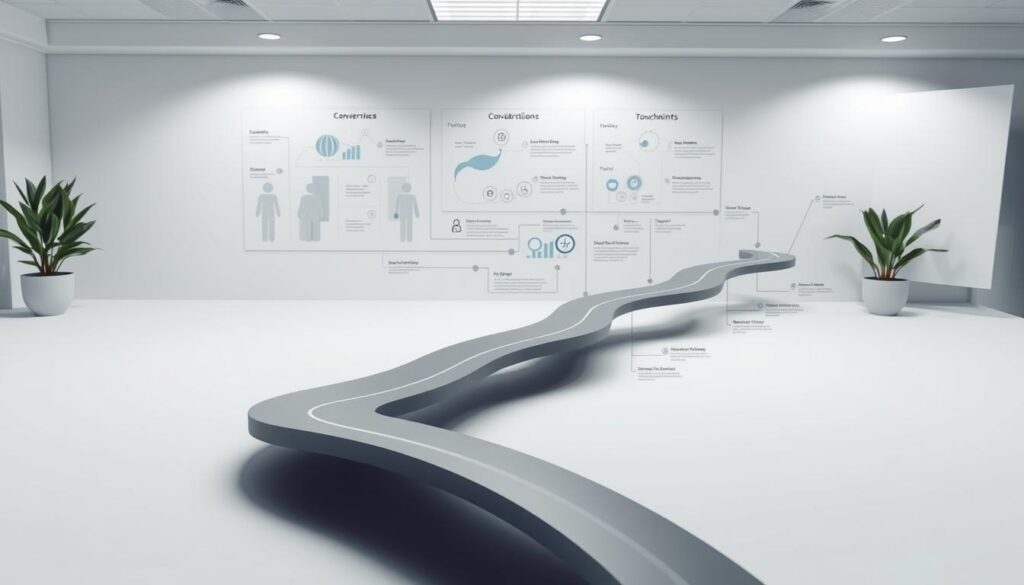New product launches face brutal odds. Harvard Business School research reveals 95% of 30,000 annual product releases fail, often due to rushed execution. With launch costs ranging from $87,000 to $535,000, businesses can’t afford missteps in today’s winner-takes-all markets.
This isn’t about luck – it’s about strategy. Companies with structured approaches see 85% higher revenue growth compared to those relying on intuition. Effective planning bridges the gap between innovative ideas and tangible results, transforming theoretical advantages into measurable success.
The difference-makers? Precision alignment of product strengths with audience needs. Successful organizations use data-driven frameworks to optimize messaging, distribution channels, and customer journeys. These methods turn speculative launches into calculated growth engines.
Key Takeaways
- 95% of new products fail without strategic market entry plans
- Launch costs exceed $500,000 for 22% of businesses
- GTM strategies drive 85% of revenue growth for top performers
- Strategic alignment reduces customer acquisition costs by 40%
- Competitive advantage stems from audience-specific messaging
Understanding the Importance of a Go-to-Market Strategy
A well-crafted gtm strategy transforms market entry from gamble to science. It acts as a compass guiding every decision – from messaging to distribution – ensuring teams don’t waste resources chasing phantom opportunities.
Market alignment sits at the strategy’s core. When products match actual customer needs, adoption rates triple. Research shows aligned launches achieve 72% faster revenue growth compared to guesswork-based approaches.
Three pillars define successful execution:
- Resource optimization: Focuses budgets on high-impact channels
- Risk mitigation: Identifies roadblocks before launch day
- Demand validation: Confirms market appetite through data
Companies using structured market strategy frameworks report 40% lower customer acquisition costs. As one tech CEO noted: “Our strategy helps us punch above our weight against industry giants.”
Ultimately, proper planning creates competitive advantage through precision timing and differentiated positioning. Organizations that master this discipline consistently outperform rivals still relying on spray-and-pray tactics.
Defining Your Target Audience and Ideal Customer Profile
Accurate customer profiling separates market leaders from struggling contenders. Organizations that precisely identify high-value buyers achieve 63% higher conversion rates than those using generic outreach. This process transforms vague assumptions into data-backed insights.
Developing Buyer Personas
Buyer personas humanize your customer segments. Effective profiles include:
- Job roles and daily challenges
- Preferred communication channels
- Primary decision-making criteria
For example: “Marketing directors at mid-sized tech firms prioritize ROI transparency over brand reputation.” This specificity helps tailor messaging to actual needs.
Identifying the Ideal Customer Profile (ICP)
An ICP filters your customer base through measurable filters. Use this framework:
| Factor | B2B Example | B2C Example |
|---|---|---|
| Industry/Demographic | SaaS companies | Urban millennials |
| Revenue/Income | $5M-$50M | $75k+ annually |
| Tech Stack/Lifestyle | CRM users | Fitness app adopters |
Companies using ICPs report 40% shorter sales cycles. The key lies in balancing firmographic data with behavioral patterns. Regular analysis ensures profiles evolve with market shifts.
Researching Market Demand and Competitor Analysis
Smart companies treat market analysis like a treasure map – it reveals hidden opportunities and dangerous pitfalls. Effective market research answers four critical questions:
- Who offers similar solutions?
- Where do rivals operate geographically?
- What makes your solution unique?
- Does genuine demand product exist?

Conducting SWOT and Competitive Analysis
A SWOT framework exposes internal capabilities and external threats. Companies using this method identify competitive advantage 38% faster than those relying on basic comparisons. Consider this tech sector example:
| Competitor | Pricing | Strengths | Weaknesses |
|---|---|---|---|
| Brand A | Premium | Established partnerships | Limited customization |
| Brand B | Budget | Rapid deployment | Poor customer support |
| Your Solution | Mid-range | AI-powered features | New market entrant |
True market demand assessment combines quantitative data with behavioral insights. Analyze search trends, industry reports, and pre-launch signups. “Three data sources beat guesswork every time,” notes a Fortune 500 strategy lead.
Refining your gtm strategy requires understanding competitor messaging blindspots. Look for underserved customer segments and pricing gaps. Companies that master this balance achieve 50% faster market penetration than industry averages.
Establishing a Unique Value Proposition and Messaging
In crowded markets, your message determines whether you shine or fade. A razor-sharp value proposition acts as both magnet and filter – attracting ideal buyers while repelling mismatched prospects. This critical component of product positioning converts features into tangible outcomes that address specific customer needs.
Crafting Benefit-Focused Messaging
Effective communication starts by answering one question: “What measurable difference will this create for the buyer?” Top performers use value matrices to align solutions with audience priorities. See how this works:
| Buyer Persona | Key Challenge | Product Solution | Core Message |
|---|---|---|---|
| IT Director | System downtime costs $9k/hour | 99.99% uptime guarantee | “Eliminate revenue-killing outages” |
| Marketing Lead | Low campaign ROI | AI performance tracking | “Turn clicks into profits” |
| Operations Head | Inefficient workflows | Automation toolkit | “Recover 15 weekly hours” |
This approach boosts message relevance by 68% compared to generic pitches. Notice how each statement focuses on outcomes rather than technical specs. Financial decision-makers see dollar figures. Time-strapped managers gain hours back.
Refining your gtm strategy requires testing messages across channels. Track which versions drive the highest engagement in marketing efforts. One SaaS company increased conversions 42% by swapping “cloud-based platform” with “stress-free compliance.”
Remember: Strong product positioning speaks the customer’s language. Use their pain points as a roadmap for crafting irresistible value propositions. When messages resonate, resistance fades.
Creating a Compelling Pricing and Revenue Model
Pricing decisions make or break market success. Research shows companies with intentional pricing strategies achieve 42% higher profit margins than those using cost-plus models. This critical component of your gtm strategy requires balancing value perception with operational realities.
- Production costs vs. perceived value
- Competitor price positioning
- Customer willingness-to-pay thresholds
Consider this comparison of common approaches:
| Model | Best For | Margin Impact |
|---|---|---|
| Subscription | Recurring services | 35-60% |
| Freemium | User adoption | 18-40% |
| Tiered | Diverse customer base | 25-50% |
Psychology plays a key role. “Price anchors shape perceived quality,” notes a pricing consultant. Positioning at $99 vs. $100 can increase conversions by 17% through perceived affordability.
The optimal strategy focuses on lifetime value rather than single transactions. Companies aligning pricing with customer success metrics see 30% higher retention rates. Regular audits ensure models adapt to changing market dynamics while protecting margins.
Mapping the Buyer’s Journey
Navigating the path from curiosity to conversion requires understanding how target customers interact with your brand. A well-mapped customer journey acts as a blueprint for delivering timely value at each decision stage. Companies using journey analytics report 58% higher conversion rates than those relying on generic outreach.

Top-of-Funnel Engagement Strategies
Early-stage buyers seek solutions to recognized problems. Effective tactics here focus on education rather than sales pitches:
- SEO-optimized guides addressing common pain points
- Webinars demonstrating industry best practices
- Social proof through third-party review platforms
These methods help potential customers discover your expertise naturally. Brands using educational content see 3x more leads than those pushing promotional material.
Middle and Bottom Funnel Techniques
As prospects move closer to decisions, shift focus to differentiation and risk reduction:
| Stage | Strategy | Success Metric |
|---|---|---|
| Consideration | Competitor comparison charts | 45% demo requests |
| Decision | Limited-time implementation support | 28% conversion lift |
| Retention | Onboarding success kits | 67% renewal rates |
Bottom-funnel efforts should address final objections. One SaaS company increased customer acquisition by 33% by adding live Q&A sessions during contract negotiations. “Removing uncertainty accelerates commitments,” notes a tech sales director.
Choosing the Right Marketing Channels for User Engagement
Channel selection dictates whether messages resonate or get lost in the noise. Strategic alignment between audience preferences and platform capabilities drives 73% higher conversion rates compared to scattergun approaches. Companies using data-driven selection achieve 2.3x faster lead generation while reducing wasted ad spend by 41%.
Digital and Social Media Platforms
Effective distribution channels function like precision tools rather than blunt instruments. A fintech marketing strategy might combine LinkedIn thought leadership with TikTok explainers for younger demographics. Consider this performance comparison:
| Platform | Best For | Conversion Lift |
|---|---|---|
| Bottom-funnel offers | 28% | |
| Brand awareness | 19% | |
| Google Ads | Immediate demand | 34% |
Integrated gtm strategies blend organic and paid tactics. One SaaS company increased demo requests by 67% using YouTube tutorials alongside retargeting ads. “Platforms are levers – pull the right combination to move your audience,” explains a digital agency CEO.
Continuous optimization separates sustainable marketing efforts from temporary wins. Monthly channel audits analyzing cost-per-lead and engagement duration prevent resource misallocation. Teams that adapt weekly based on performance data see 55% higher ROI year-over-year.
Leveraging Sales Strategies in Your GTM Approach
Strategic alignment between product offerings and sales processes determines revenue velocity. Companies that match their sales strategy to customer expectations see 58% higher deal closure rates than those using one-size-fits-all approaches.
- Self-service: Digital-first purchasing
- Inside sales: Guided remote transactions
- Field sales: High-touch enterprise deals
- Channel: Partner-driven distribution
Self-Service vs. Field Sales Models
| Model | Avg. Deal Size | Sales Cycle | Best For |
|---|---|---|---|
| Self-Service | $500 | 3 days | Standardized solutions |
| Field Sales | $75k+ | 90 days | Complex customer base |
Self-service models reduce operational costs by 47% through automation. Field teams deliver 3x higher contract values but require 60% more resources. Hybrid approaches balance these extremes – 68% of tech firms now combine digital tools with personalized support.
The optimal sales process adapts to buyer sophistication. Simple products thrive with minimal intervention, while complex solutions need expert guidance. As one revenue leader notes: “Our inside sales team handles 80% of initial engagements, freeing field reps for strategic accounts.”
Implementing Go to Market User Engagement Tactics
Execution separates vision from results. Turning a gtm strategy into action demands disciplined workflows that align teams and track progress. Start by mapping every task to specific owners with clear deadlines – ambiguity derails even brilliant plans.
Effective implementation requires three operational pillars. First, standardized communication cadences keep stakeholders informed without overload. Second, milestone tracking through shared dashboards maintains accountability. Third, built-in review points let teams adapt the marketing plan based on real-time data.
Feedback loops ensure product launches stay customer-centric. Monitor support tickets, social sentiment, and usage patterns weekly. Teams that adjust messaging within 14 days of launch see 22% higher retention rates. One SaaS company improved their customer experience by implementing live chat during onboarding – satisfaction scores jumped 41%.
Cross-functional collaboration cements success. Sales teams need battle-tested objection handlers. Support requires updated troubleshooting guides. Marketing must refine campaigns using early adopter insights. When departments synchronize efforts, the gtm strategy evolves from document to growth engine.
FAQ
How does a go-to-market strategy differ from general marketing plans?
A go-to-market strategy specifically focuses on launching products/services in new markets or segments, aligning cross-functional teams around measurable objectives. Marketing plans address ongoing brand awareness and lead generation across existing markets.
What defines an ideal customer profile in B2B markets?
An ideal customer profile combines firmographic data (company size, industry), technographic insights (existing tools), and behavioral patterns. For SaaS platforms like HubSpot, this might target mid-market companies with 200-1,000 employees seeking marketing automation.
Which market research methods prove most effective for GTM planning?
Competitor benchmarking through tools like SEMrush, customer interviews uncovering unmet needs, and conjoint analysis for pricing validation deliver actionable insights. Salesforce uses win/loss analysis to refine its enterprise positioning.
How do value propositions differ from product positioning?
Value propositions articulate specific customer benefits (“Reduce cloud costs by 30%”), while positioning establishes market relativity against alternatives. AWS emphasizes scalability as positioning, while its value proposition highlights pay-as-you-go pricing.
What pricing models align with customer lifetime value goals?
Tiered pricing (Basic/Pro/Enterprise) matches varying customer segments, while usage-based models suit scalable products like Twilio. Adobe’s shift to Creative Cloud subscriptions increased recurring revenue by 85% over three years.
Which buyer journey stages require distinct engagement tactics?
Top-funnel strategies use educational content (webinars, whitepapers), middle-funnel employs product demos and case studies, while bottom-funnel leverages free trials and ROI calculators. HubSpot’s Academy drives 73% of qualified leads through middle-funnel content.
When should companies prioritize self-service vs field sales models?
Self-service suits standardized SaaS products under k/year (Dropbox), while complex enterprise solutions (SAP ERP) require dedicated account executives. Slack’s hybrid model combines freemium onboarding with premium support tiers.
What key performance indicators track GTM success effectively?
Critical metrics include customer acquisition cost payback period, trial-to-paid conversion rates, and net revenue retention. Zoom monitors daily active users/meetings as engagement indicators post-launch.
How do distribution channels impact market entry strategies?
Direct sales enable premium positioning (Snowflake), while app marketplaces accelerate SMB adoption. Shopify’s partner ecosystem drives 35% of new merchant acquisitions through theme developers and agencies.
What post-launch optimizations sustain user engagement?
Continuous A/B testing of onboarding flows, feature adoption tracking through Mixpanel, and customer health scoring prevent churn. Canva’s template library updates increased user session duration by 40% quarterly.



